Submitted:
21 June 2023
Posted:
21 June 2023
You are already at the latest version
Abstract
Keywords:
1. Introduction
2. Materials and Methods
Materials
Synthesis of pure BiFeO3
Synthesis of pure ZnIn2S4
Synthesis of BiFeO3/ZnIn2S4 heterojunction
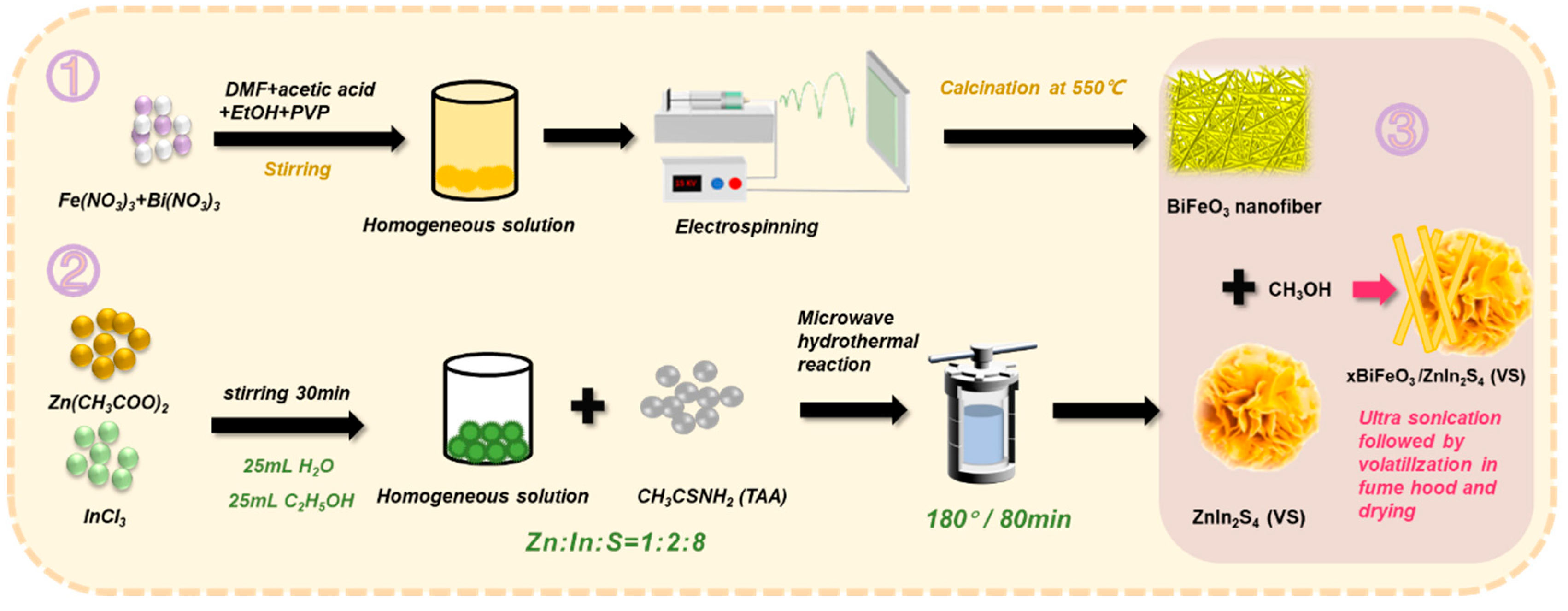
Characterization
3. Results
4. Conclusions
Author Contributions
Funding
Data Availability Statement
Acknowledgments
Conflicts of Interest
References
- Wang, T.; Liu, X.Q.; Men, Q.Y.; Ma, C.C.; Liu, Y.; Huo, P.W.; Yan, Y.S. A Z-scheme TiO2 quantum dots fragment-Bi12TiO20 composites for enhancing photocatalytic activity. Renewable Energy 2020, 147, 856–863. [Google Scholar] [CrossRef]
- Jiang, J.; Li, H.; Zhang, L.Z. New Insight into Daylight Photocatalysis of AgBr@Ag: Synergistic Effect between Semiconductor Photocatalysis and Plasmonic Photocatalysis. Chemistry-a European Journal 2012, 18, 6360–6369. [Google Scholar] [CrossRef]
- Nur, A.S.M.; Sultana, M.; Mondal, A.; Islam, S.; Robel, F.N.; Islam, A.; Sumi, M.S.A. A review on the development of elemental and codoped TiO2 photocatalysts for enhanced dye degradation under UV-vis irradiation. Journal of Water Process Engineering 2022, 47. [Google Scholar] [CrossRef]
- Habisreutinger, S.N.; Schmidt-Mende, L.; Stolarczyk, J.K. Photocatalytic Reduction of CO2 on TiO2 and Other Semiconductors. Angew. Chem.-Int. Edit. 2013, 52, 7372–7408. [Google Scholar] [CrossRef] [PubMed]
- Munoz, I.; Rieradevall, J.; Torrades, F.; Peral, J.; Domenech, X. Environmental assessment of different solar driven advanced oxidation processes. Solar Energy 2005, 79, 369–375. [Google Scholar] [CrossRef]
- Adeyemi, J.O.; Ajiboye, T.; Onwudiwe, D.C. Mineralization of Antibiotics in Wastewater Via Photocatalysis. Water Air and Soil Pollution 2021, 232. [Google Scholar] [CrossRef]
- Low, J.X.; Cheng, B.; Yu, J.G. Surface modification and enhanced photocatalytic CO2 reduction performance of TiO2: a review. Appl. Surf. Sci. 2017, 392, 658–686. [Google Scholar] [CrossRef]
- Kurnaravel, V.; Mathew, S.; Bartlett, J.; Pillai, S.C. Photocatalytic hydrogen production using metal doped TiO2: A review of recent advances. Applied Catalysis B-Environmental 2019, 244, 1021–1064. [Google Scholar] [CrossRef]
- Wang, C.C.; Zhan, Y.; Wang, Z.Y. TiO2, MoS2, and TiO2/MoS2 Heterostructures for Use in Organic Dyes Degradation. Chemistryselect 2018, 3, 1713–1718. [Google Scholar] [CrossRef]
- Yu, J.G.; Yu, Y.F.; Zhou, P.; Xiao, W.; Cheng, B. Morphology-dependent photocatalytic H-2-production activity of CdS. Applied Catalysis B-Environmental 2014, 156, 184–191. [Google Scholar] [CrossRef]
- Kumar, A.; Khosla, A.; Sharma, S.K.; Dhiman, P.; Sharma, G.; Gnanasekaran, L.; Naushad, M.; Stadler, F.J. A review on S-scheme and dual S-scheme heterojunctions for photocatalytic hydrogen evolution, water detoxification and CO2 reduction. Fuel 2023, 333. [Google Scholar] [CrossRef]
- Jiang, D.L.; Li, J.; Xing, C.S.; Zhang, Z.Y.; Meng, S.; Chen, M. Two-Dimensional Caln(2)S(4)/g-C3N4 Heterojunction Nanocomposite with Enhanced Visible-Light Photocatalytic Activities: Interfacial Engineering and Mechanism Insight. Acs Applied Materials & Interfaces 2015, 7, 19234–19242. [Google Scholar] [CrossRef]
- Zeng, R.J.; Lian, K.K.; Su, B.; Lu, L.L.; Lin, J.W.; Tang, D.P.; Lin, S.; Wang, X.C. Versatile Synthesis of Hollow Metal Sulfides via Reverse Cation Exchange Reactions for Photocatalytic CO2 Reduction. Angew. Chem.-Int. Edit. 2021, 60, 25055–25062. [Google Scholar] [CrossRef] [PubMed]
- Toe, C.Y.; Zhou, S.J.; Gunawan, M.; Lu, X.N.; Ng, Y.H.; Amal, R. Recent advances and the design criteria of metal sulfide photocathodes and photoanodes for photoelectrocatalysis. Journal of Materials Chemistry A 2021, 9, 20277–20319. [Google Scholar] [CrossRef]
- Wang, J.; Sun, S.J.; Zhou, R.; Li, Y.Z.; He, Z.T.; Ding, H.; Chen, D.M.; Ao, W.H. A review: Synthesis, modification and photocatalytic applications of ZnIn2S4. J. Mater. Sci. Technol. 2021, 78, 1–19. [Google Scholar] [CrossRef]
- Wang, J.J.; Lin, S.; Tian, N.; Ma, T.Y.; Zhang, Y.H.; Huang, H.W. Nanostructured Metal Sulfides: Classification, Modification Strategy, and Solar-Driven CO2 Reduction Application. Advanced Functional Materials 2021, 31. [Google Scholar] [CrossRef]
- Kolny-Olesiak, J.; Weller, H. Synthesis and Application of Colloidal CuInS2 Semiconductor Nanocrystals. Acs Applied Materials & Interfaces 2013, 5, 12221–12237. [Google Scholar] [CrossRef]
- Ozdemir, S.; Bucurgat, M.; Firat, T. Characteristics of traps in AgIn5S8 single crystals. Journal of Alloys and Compounds 2014, 611, 7–10. [Google Scholar] [CrossRef]
- Chong, W.K.; Ng, B.J.; Tan, L.L.; Chai, S.P. Recent Advances in Nanoscale Engineering of Ternary Metal Sulfide-Based Heterostructures for Photocatalytic Water SplittingApplications. Energy & Fuels 2022, 36, 4250–4267. [Google Scholar] [CrossRef]
- Yang, J.M.; Yang, Z.R.; Yang, K.F.; Yu, Q.; Zhu, X.W.; Xu, H.; Li, H.M. Indium-based ternary metal sulfide for photocatalytic CO2 reduction application. Chinese Journal of Catalysis 2023, 44, 67–95. [Google Scholar] [CrossRef]
- Aljuaid, A.; Almehmadi, M.; Alsaiari, A.A.; Allahyani, M.; Abdulaziz, O.; Alsharif, A.; Alsaiari, J.A.; Saih, M.; Alotaibi, R.T.; Khan, I. g-C3N4 Based Photocatalyst for the Efficient Photodegradation of Toxic Methyl Orange Dye: Recent Modifications and Future Perspectives. Molecules 2023, 28. [Google Scholar] [CrossRef] [PubMed]
- Matsuoka, H.; Higashi, M.; Nakada, A.; Tomita, O.; Abe, R. Enhanced H-2 Evolution on ZnIn2S4 Photocatalyst under Visible Light by Surface Modification with Metal Cyanoferrates. Chemistry Letters 2018, 47, 941–944. [Google Scholar] [CrossRef]
- Li, Q.; Xia, Y.; Yang, C.; Lv, K.L.; Lei, M.; Li, M. Building a direct Z-scheme heterojunction photocatalyst by ZnIn2S4 nanosheets and TiO2 hollowspheres for highly-efficient artificial photosynthesis. Chem. Eng. J. 2018, 349, 287–296. [Google Scholar] [CrossRef]
- Yang, R.J.; Mei, L.; Fan, Y.Y.; Zhang, Q.Y.; Zhu, R.S.; Amal, R.; Yin, Z.Y.; Zeng, Z.Y. ZnIn2S4-Based Photocatalysts for Energy and Environmental Applications. Small Methods 2021, 5. [Google Scholar] [CrossRef] [PubMed]
- Chen, J.; Li, K.; Cai, X.Y.; Zhao, Y.L.; Gu, X.Q.; Mao, L. Sulfur vacancy-rich ZnIn2S4 nanosheet arrays for visible-light-driven water splitting. Materials Science in Semiconductor Processing 2022, 143. [Google Scholar] [CrossRef]
- Wu, Z.X.; Zhao, Y.; Jin, W.; Jia, B.H.; Wang, J.; Ma, T.Y. Recent Progress of Vacancy Engineering for Electrochemical Energy Conversion Related Applications. Advanced Functional Materials 2021, 31. [Google Scholar] [CrossRef]
- Xu, X.; Ding, X.; Yang, X.L.; Wang, P.; Li, S.; Lu, Z.X.; Chen, H. Oxygen vacancy boosted photocatalytic decomposition of ciprofloxacin over Bi2MoO6: Oxygen vacancy engineering, biotoxicity evaluation and mechanism study. Journal of Hazardous Materials 2019, 364, 691–699. [Google Scholar] [CrossRef]
- Xu, Q.L.; Zhang, L.Y.; Cheng, B.; Fan, J.J.; Yu, J.G. S-Scheme Heterojunction Photocatalyst. Chem 2020, 6, 1543–1559. [Google Scholar] [CrossRef]
- Zhang, L.Y.; Zhang, J.J.; Yu, H.G.; Yu, J.G. Emerging S-Scheme Photocatalyst. Advanced Materials 2022, 34. [Google Scholar] [CrossRef]
- Dhawan, A.; Sudhaik, A.; Raizada, P.; Thakur, S.; Ahamad, T.; Thakur, P.; Singh, P.; Hussain, C.M. BiFeO3-based Z scheme photocatalytic systems: Advances, mechanism, and applications. Journal of Industrial and Engineering Chemistry 2023, 117, 1–20. [Google Scholar] [CrossRef]
- You, H.L.; Wu, Z.; Zhang, L.H.; Ying, Y.R.; Liu, Y.; Fei, L.F.; Chen, X.X.; Jia, Y.M.; Wang, Y.J.; Wang, F.F.; et al. Harvesting the Vibration Energy of BiFeO3 Nanosheets for Hydrogen Evolution. Angew. Chem.-Int. Edit. 2019, 58, 11779–11784. [Google Scholar] [CrossRef] [PubMed]
- Zhang, X.Y.; Wang, X.; Chai, J.N.; Xue, S.; Wang, R.X.; Jiang, L.; Wang, J.; Zhang, Z.H.; Dionysiou, D.D. Construction of novel symmetric double Z-scheme BiFeO3/CuBi2O4/BaTiO3 photocatalyst with enhanced solar-light-driven photocatalytic performance for degradation of norfloxacin. Applied Catalysis B-Environmental 2020, 272. [Google Scholar] [CrossRef]
- Hu, S.J.; Jin, L.; Si, W.Y.; Wang, B.L.; Zhu, M.S. Sulfur Vacancies Enriched 2D ZnIn2S4 Nanosheets for Improving Photoelectrochemical Performance. Catalysts 2022, 12. [Google Scholar] [CrossRef]
- Chen, Y.J.; Hu, S.W.; Liu, W.J.; Chen, X.Y.; Wu, L.; Wang, X.X.; Liu, P.; Li, Z.H. Controlled syntheses of cubic and hexagonal ZnIn2S4 nanostructures with different visible-light photocatalytic performance. Dalton Transactions 2011, 40, 2607–2613. [Google Scholar] [CrossRef] [PubMed]
- Mostafavi, E.; Ataie, A. Destructive Interactions between Pore Forming Agents and Matrix Phase during the Fabrication Process of Porous BiFeO3 Ceramics. J. Mater. Sci. Technol. 2015, 31, 798–805. [Google Scholar] [CrossRef]
- Qin, Y.Y.; Li, H.; Lu, J.; Feng, Y.H.; Meng, F.Y.; Ma, C.C.; Yan, Y.S.; Meng, M.J. Synergy between van der waals heterojunction and vacancy in ZnIn2S4/g-C3N4 2D/2D photocatalysts for enhanced photocatalytic hydrogen evolution. Applied Catalysis B-Environmental 2020, 277. [Google Scholar] [CrossRef]
- Peng, Y.H.; Geng, M.J.; Yu, J.Q.; Zhang, Y.; Tian, F.H.; Guo, Y.N.; Zhang, D.S.; Yang, X.L.; Li, Z.; Li, Z.X.; et al. Vacancy-induced 2H@1T MoS2 phase-incorporation on ZnIn2S4 for boosting photocatalytic hydrogen evolution. Applied Catalysis B-Environmental 2021, 298. [Google Scholar] [CrossRef]
- Ma, Y.; Lv, P.; Duan, F.; Sheng, J.L.; Lu, S.L.; Zhu, H.; Du, M.L.; Chen, M.Q. Direct Z-scheme Bi2S3/BiFeO3 heterojunction nanofibers with enhanced photocatalytic activity. Journal of Alloys and Compounds 2020, 834. [Google Scholar] [CrossRef]
- Jiang, J.Z.; Zou, J.; Anjum, M.N.; Yan, J.C.; Huang, L.; Zhang, Y.X.; Chen, J.F. Synthesis and characterization of wafer-like BiFeO3 with efficient catalytic activity. Solid State Sciences 2011, 13, 1779–1785. [Google Scholar] [CrossRef]
- Lv, H.L.; Zhao, H.Y.; Cao, T.C.; Qian, L.; Wang, Y.B.; Zhao, G.H. Efficient degradation of high concentration azo-dye wastewater by heterogeneous Fenton process with iron-based metal-organic framework. Journal of Molecular Catalysis a-Chemical 2015, 400, 81–89. [Google Scholar] [CrossRef]
- Li, S.; Tang, J.C.; Liu, Q.L.; Liu, X.M.; Gao, B. A novel stabilized carbon-coated nZVI as heterogeneous persulfate catalyst for enhanced degradation of 4-chlorophenol. Environment International 2020, 138. [Google Scholar] [CrossRef] [PubMed]
- Zhang, G.H.; Yuan, X.X.; Xie, B.; Meng, Y.; Ni, Z.M.; Xia, S.J. S vacancies act as a bridge to promote electron injection from Z-scheme heterojunction to nitrogen molecule for photocatalytic ammonia synthesis. Chem. Eng. J. 2022, 433. [Google Scholar] [CrossRef]
- Lam, S.M.; Jaffari, Z.H.; Sin, J.C.; Zeng, H.H.; Lin, H.; Li, H.X.; Mohamed, A.R. Insight into the influence of noble metal decorated on BiFeO3 for 2,4-dichlorophenol and real herbicide wastewater treatment under visible light. Colloids and Surfaces a-Physicochemical and Engineering Aspects 2021, 614. [Google Scholar] [CrossRef]
- Wang, X.H.; Wang, X.H.; Huang, J.F.; Li, S.X.; Meng, A.; Li, Z.J. Interfacial chemical bond and internal electric field modulated Z-scheme S-v-ZnIn2S4/MoSe2 photocatalyst for efficient hydrogen evolution. Nature Communications 2021, 12. [Google Scholar] [CrossRef]
- Ran, Q.; Yu, Z.B.; Jiang, R.H.; Hou, Y.P.; Huang, J.; Zhu, H.X.; Yang, F.; Li, M.J.; Li, F.Y.; Sun, Q.Q. A novel, noble-metal-free core-shell structure Ni-P@C cocatalyst modified sulfur vacancy-rich ZnIn2S4 2D ultrathin sheets for visible light-driven photocatalytic hydrogen evolution. Journal of Alloys and Compounds 2021, 855. [Google Scholar] [CrossRef]
- Wang, X.; He, X.S.; Li, C.Y.; Liu, S.L.; Lu, W.; Xiang, Z.; Wang, Y. Sonocatalytic removal of tetracycline in the presence of S-scheme Cu2O/ BiFeO3 heterojunction: Operating parameters, mechanisms, degradation pathways and toxicological evaluation. Journal of Water Process Engineering 2023, 51. [Google Scholar] [CrossRef]
- Wang, L.B.; Cheng, B.; Zhang, L.Y.; Yu, J.G. In situ Irradiated XPS Investigation on S-Scheme TiO2@ZnIn2S4 Photocatalyst for Efficient Photocatalytic CO2 Reduction. Small 2021, 17. [Google Scholar] [CrossRef]
- Huang, Y.C.; Li, H.B.; Balogun, M.S.; Liu, W.Y.; Tong, Y.X.; Lu, X.H.; Ji, H.B. Oxygen Vacancy Induced Bismuth Oxyiodide with Remarkably Increased Visible-Light Absorption and Superior Photocatalytic Performance. Acs Applied Materials & Interfaces 2014, 6, 22920–22927. [Google Scholar] [CrossRef]
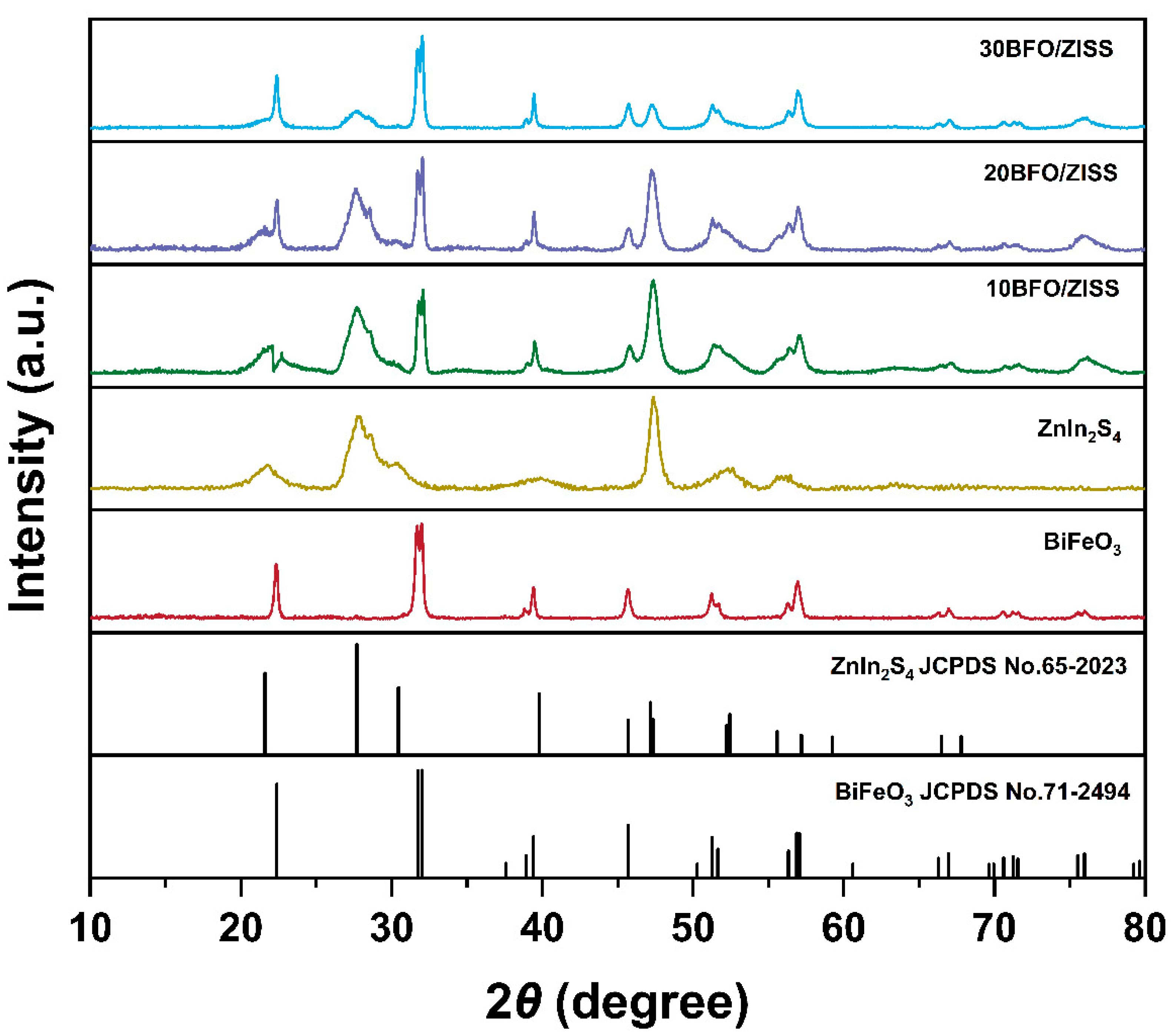
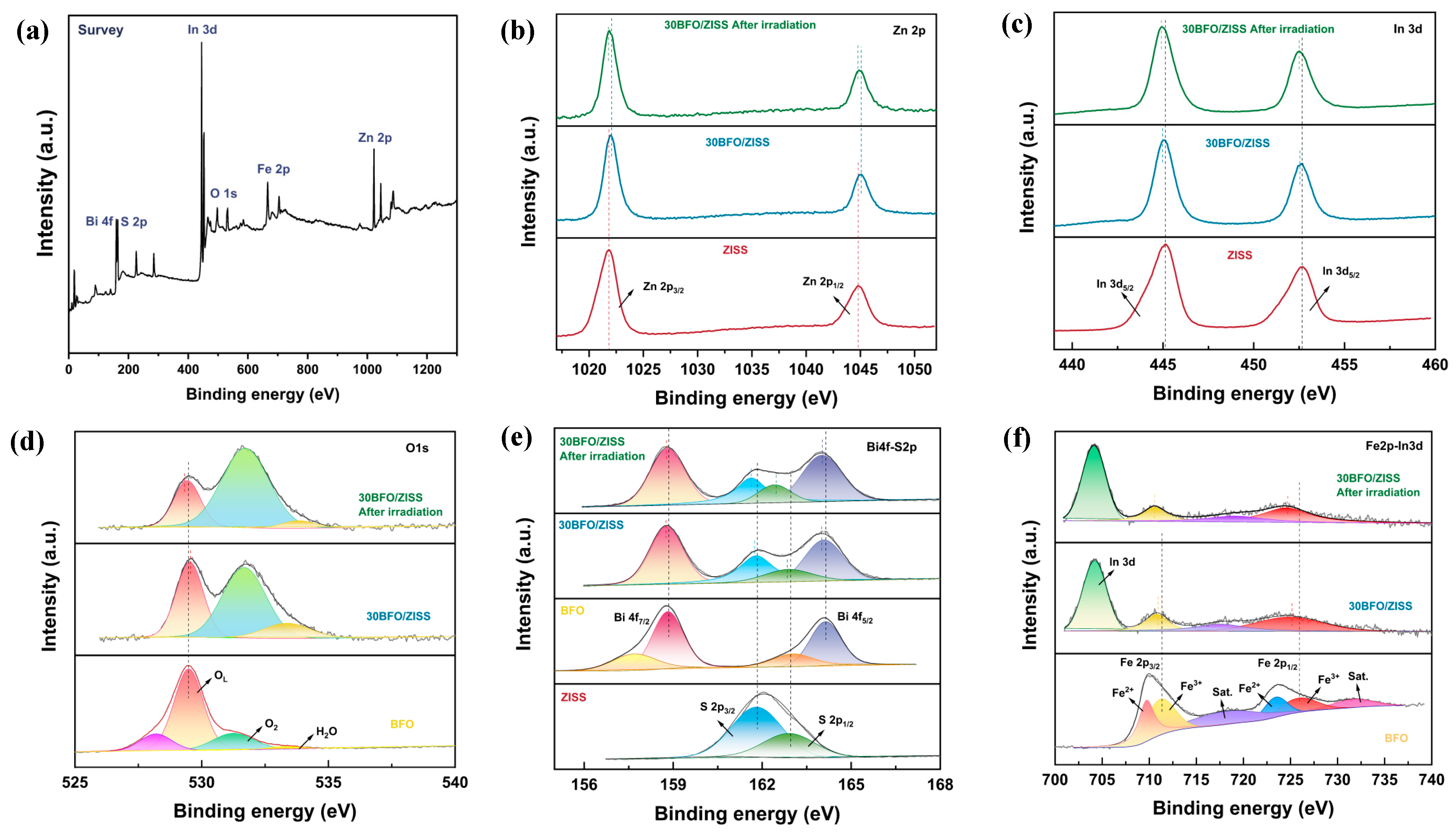
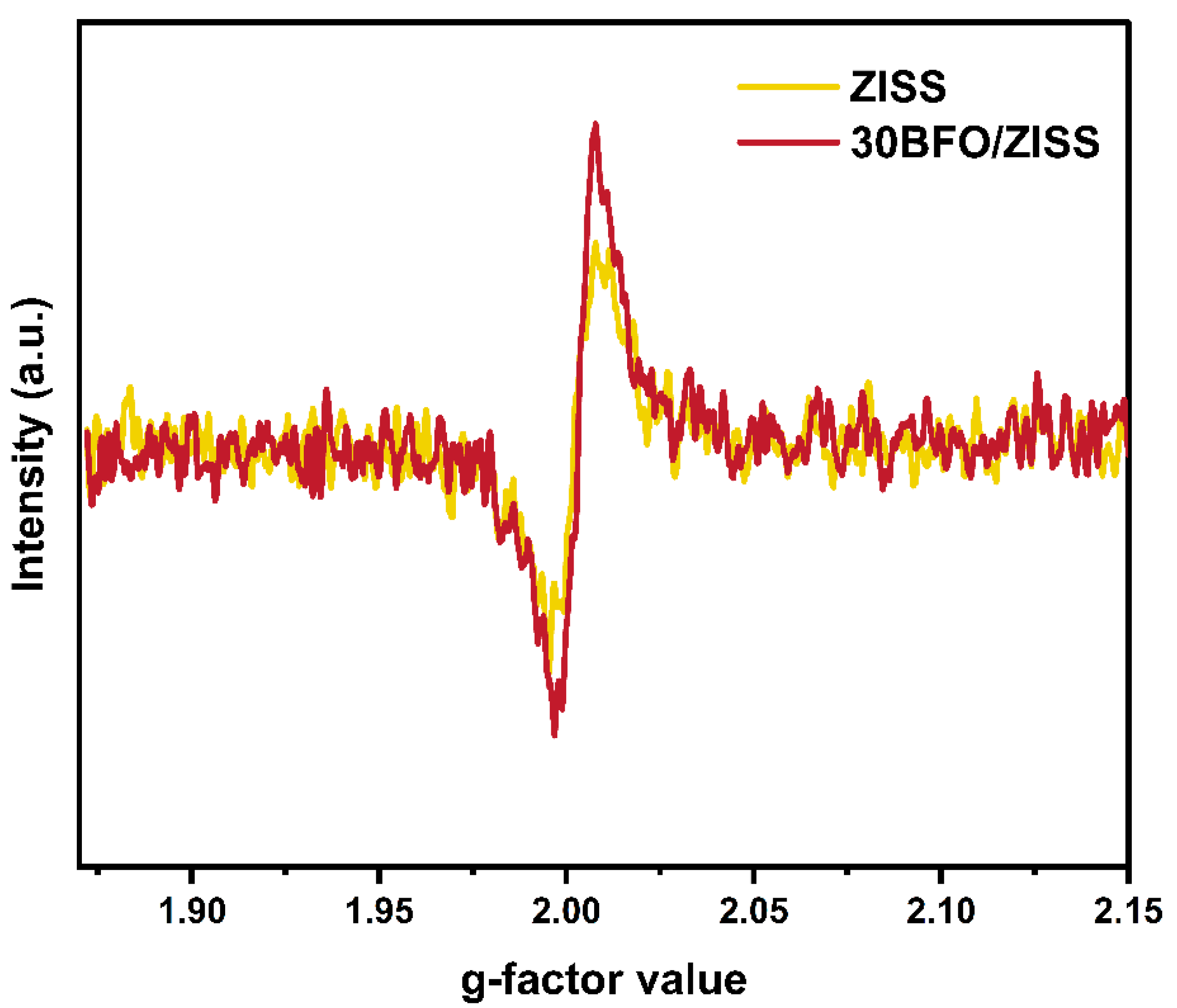
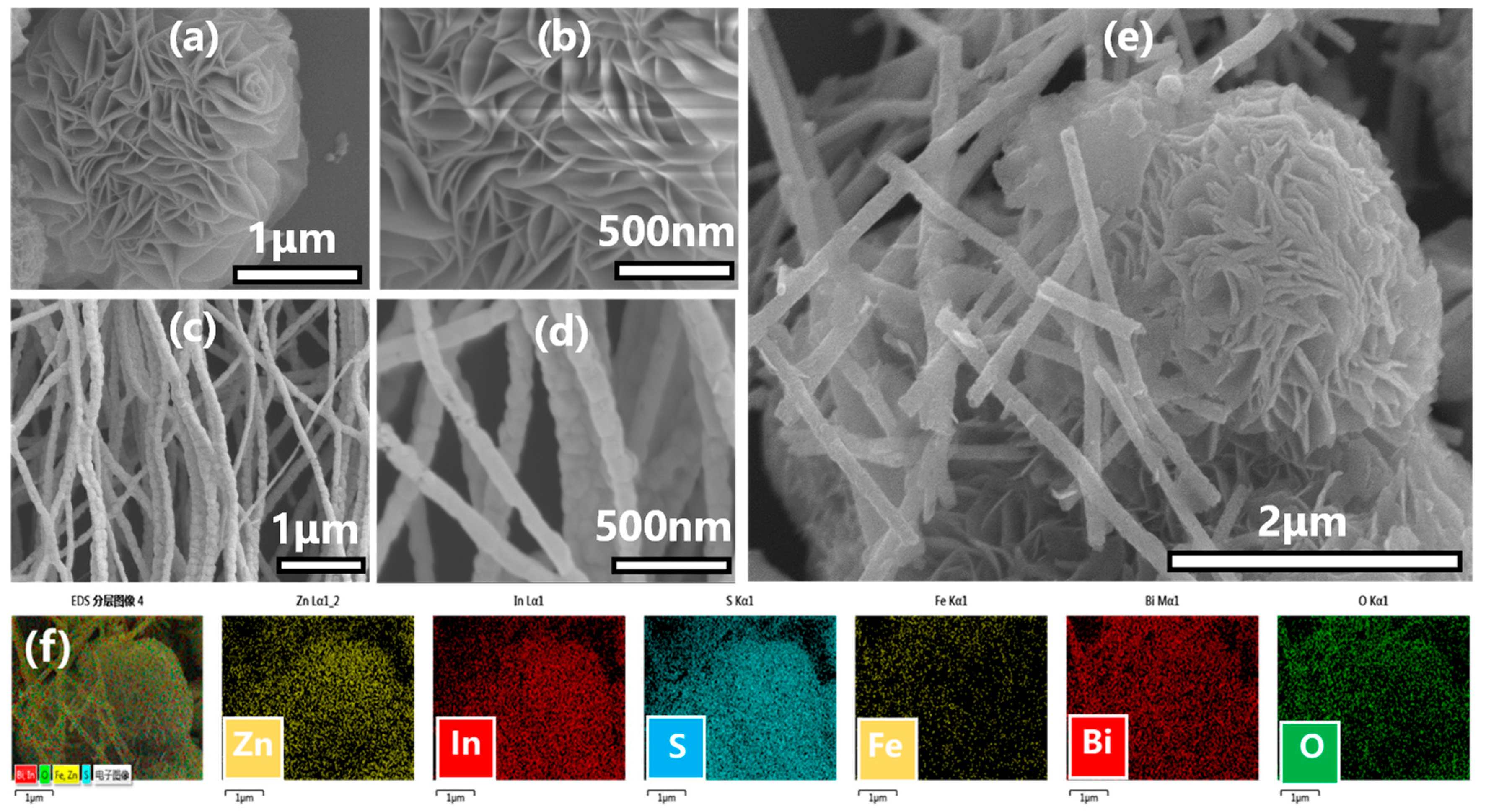
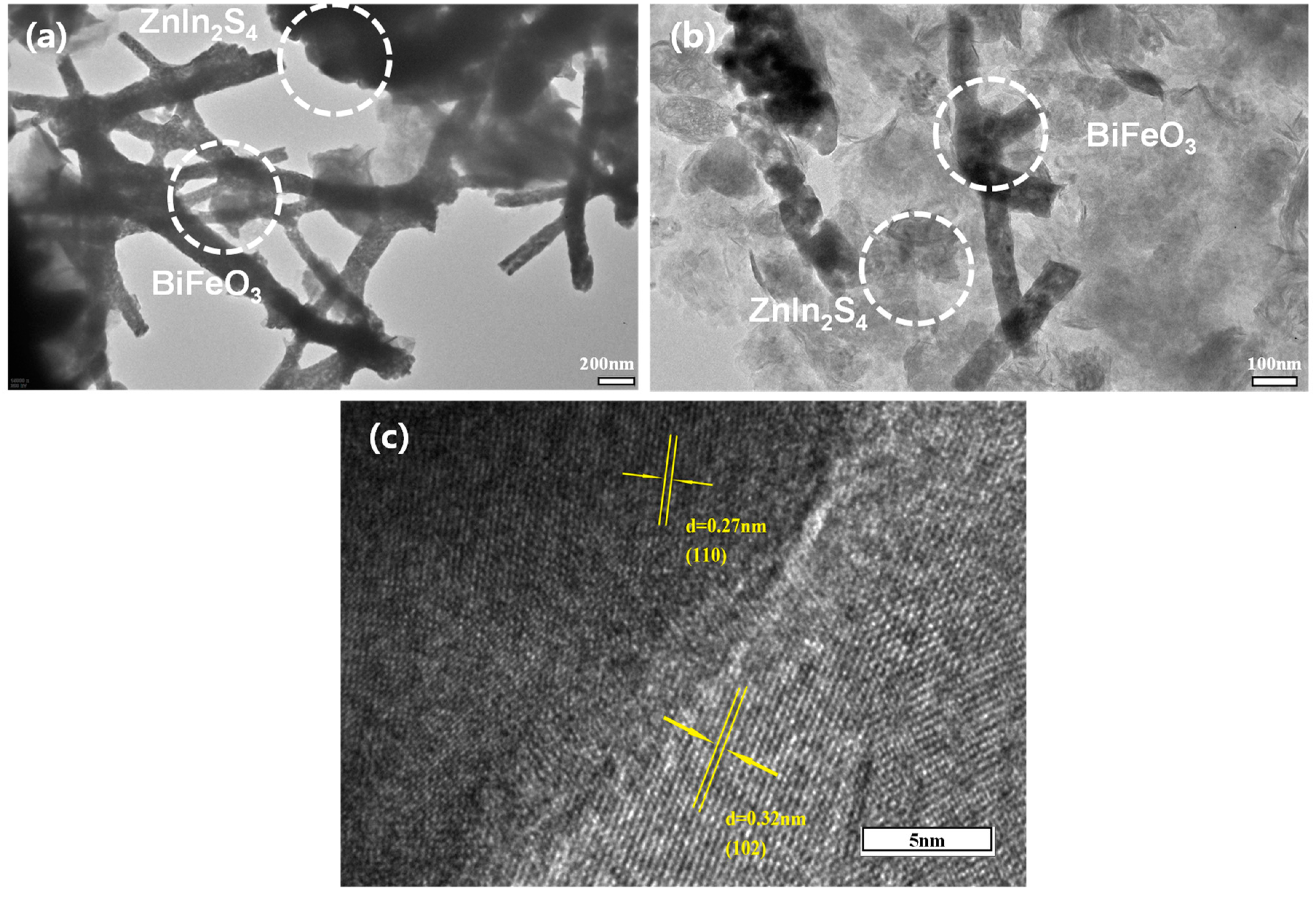
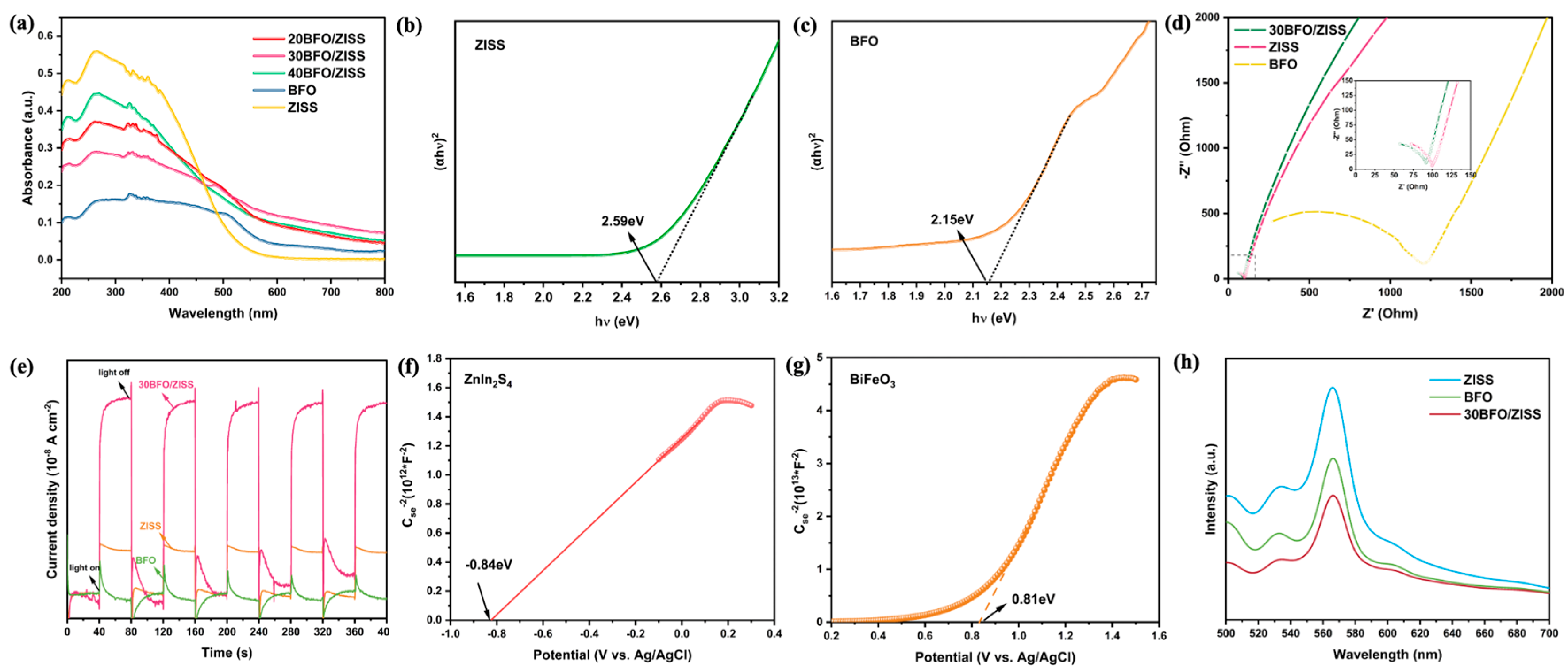
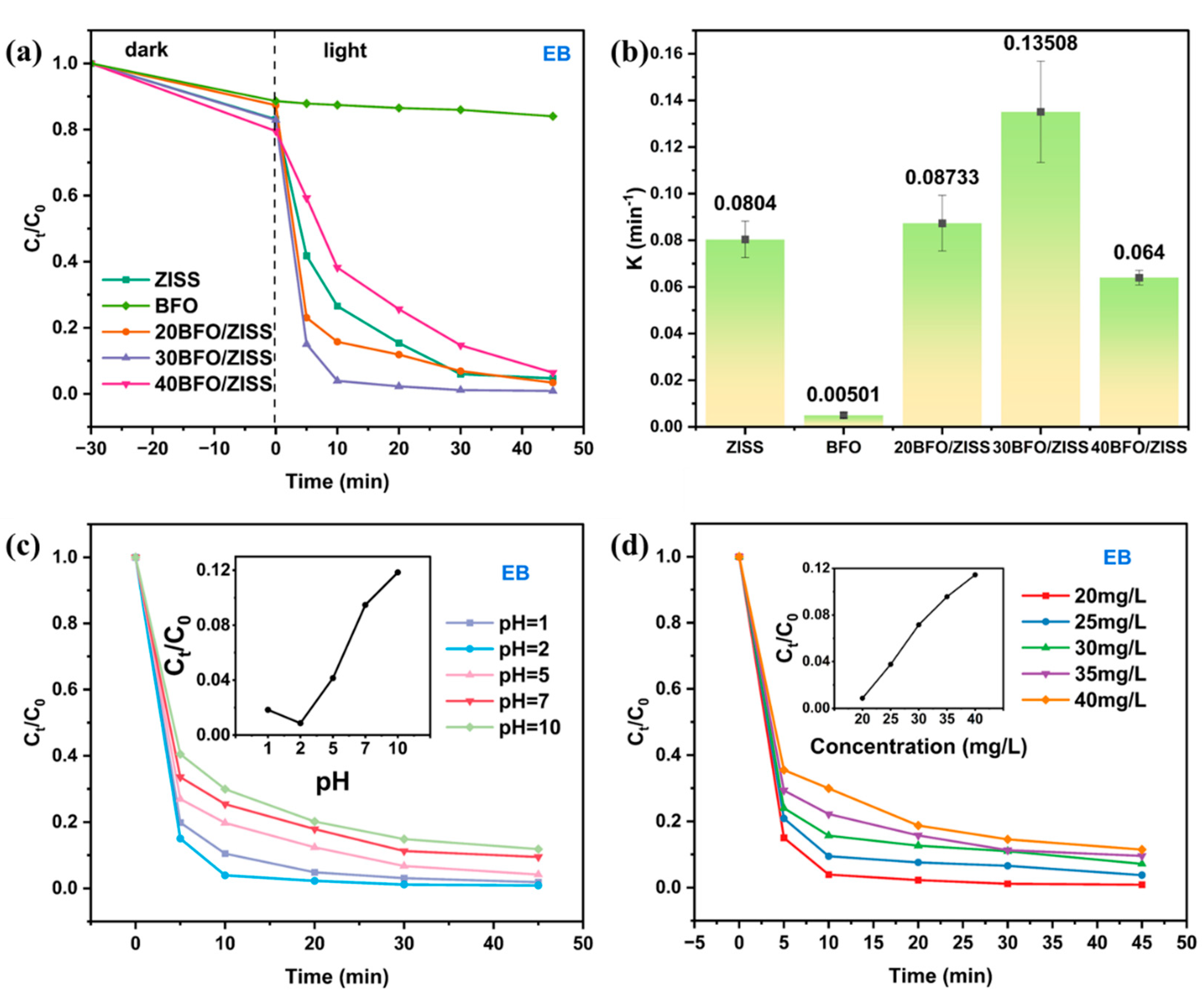
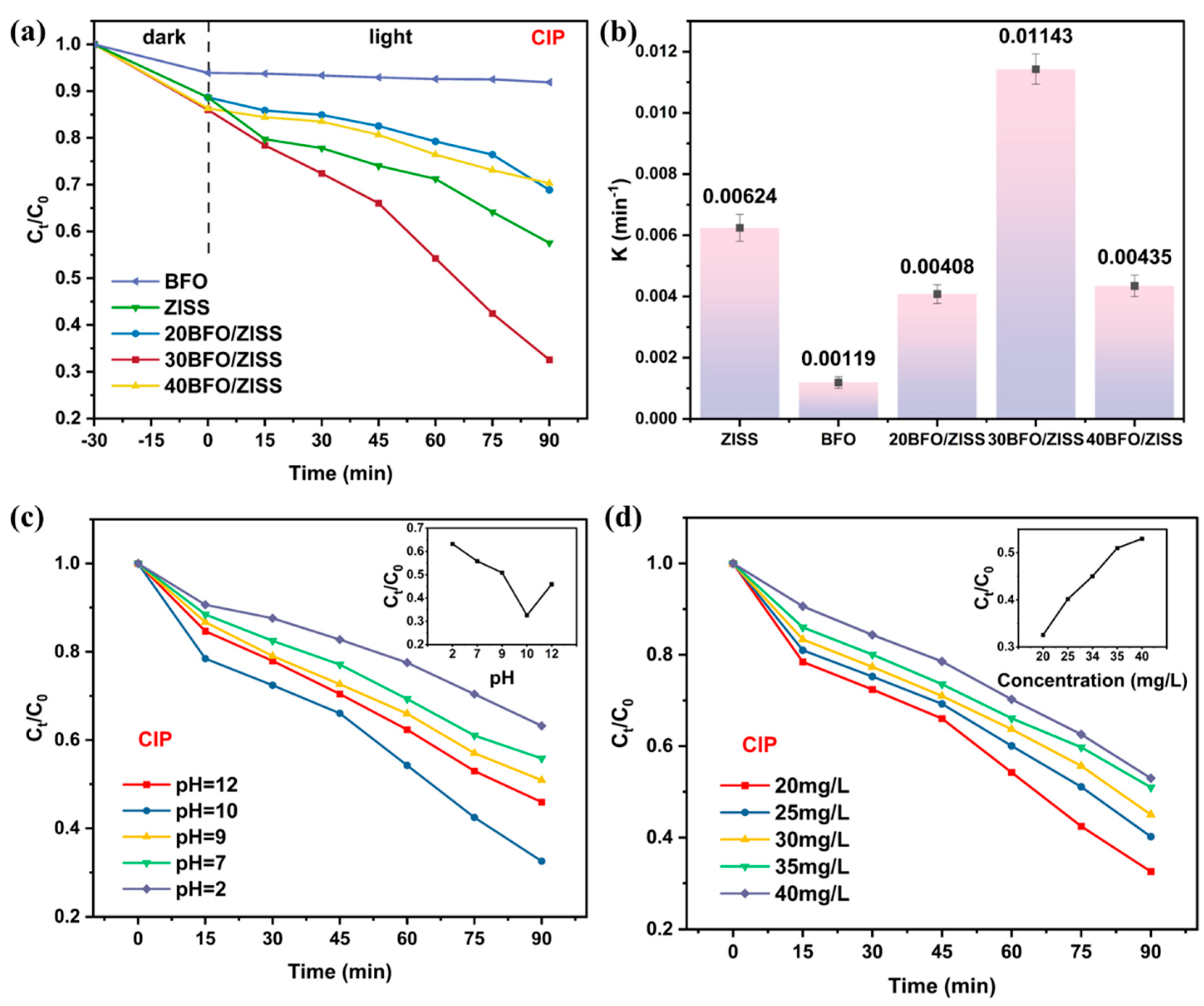
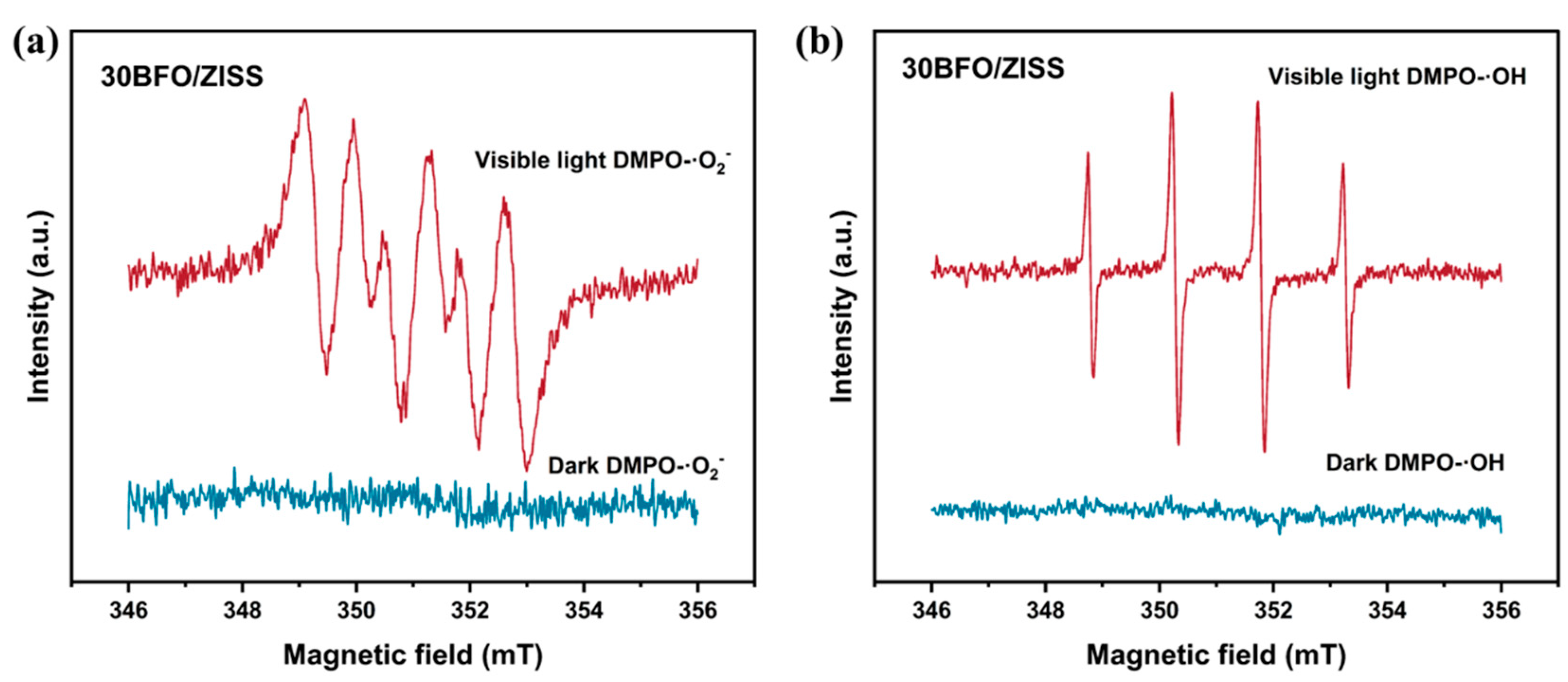
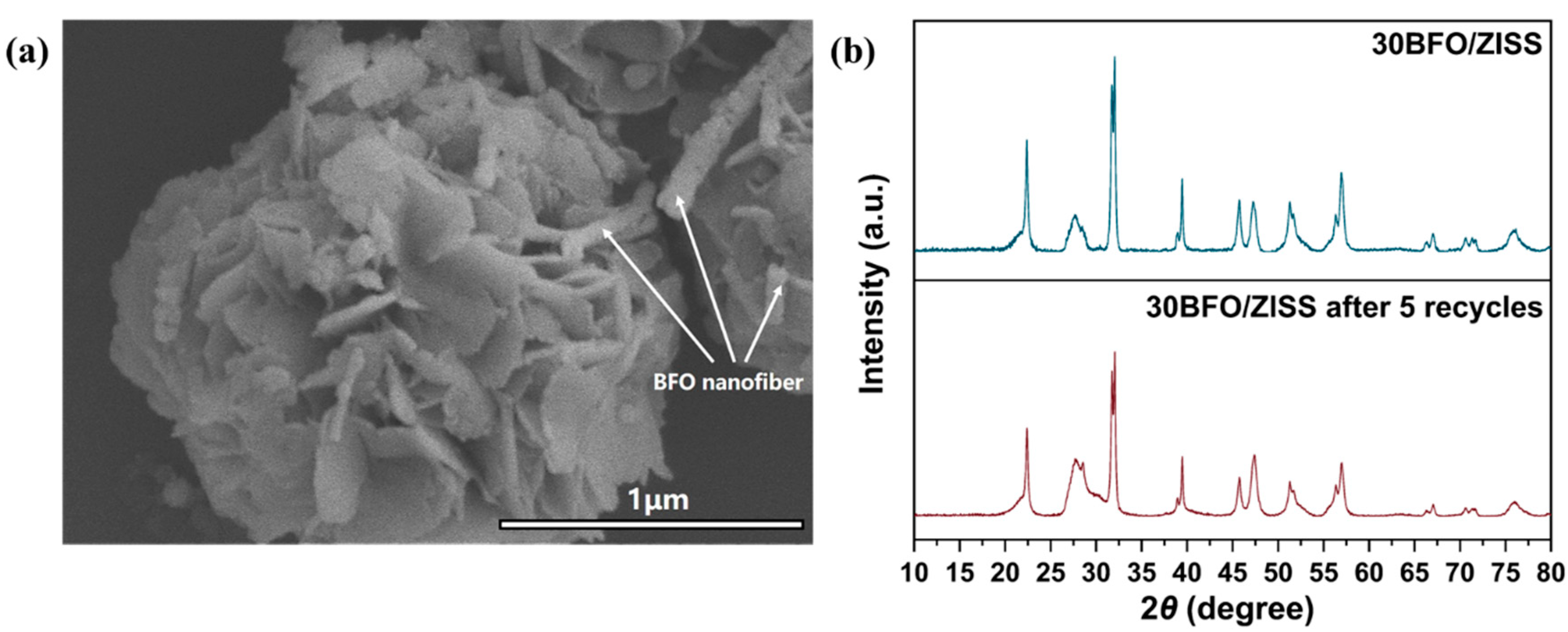
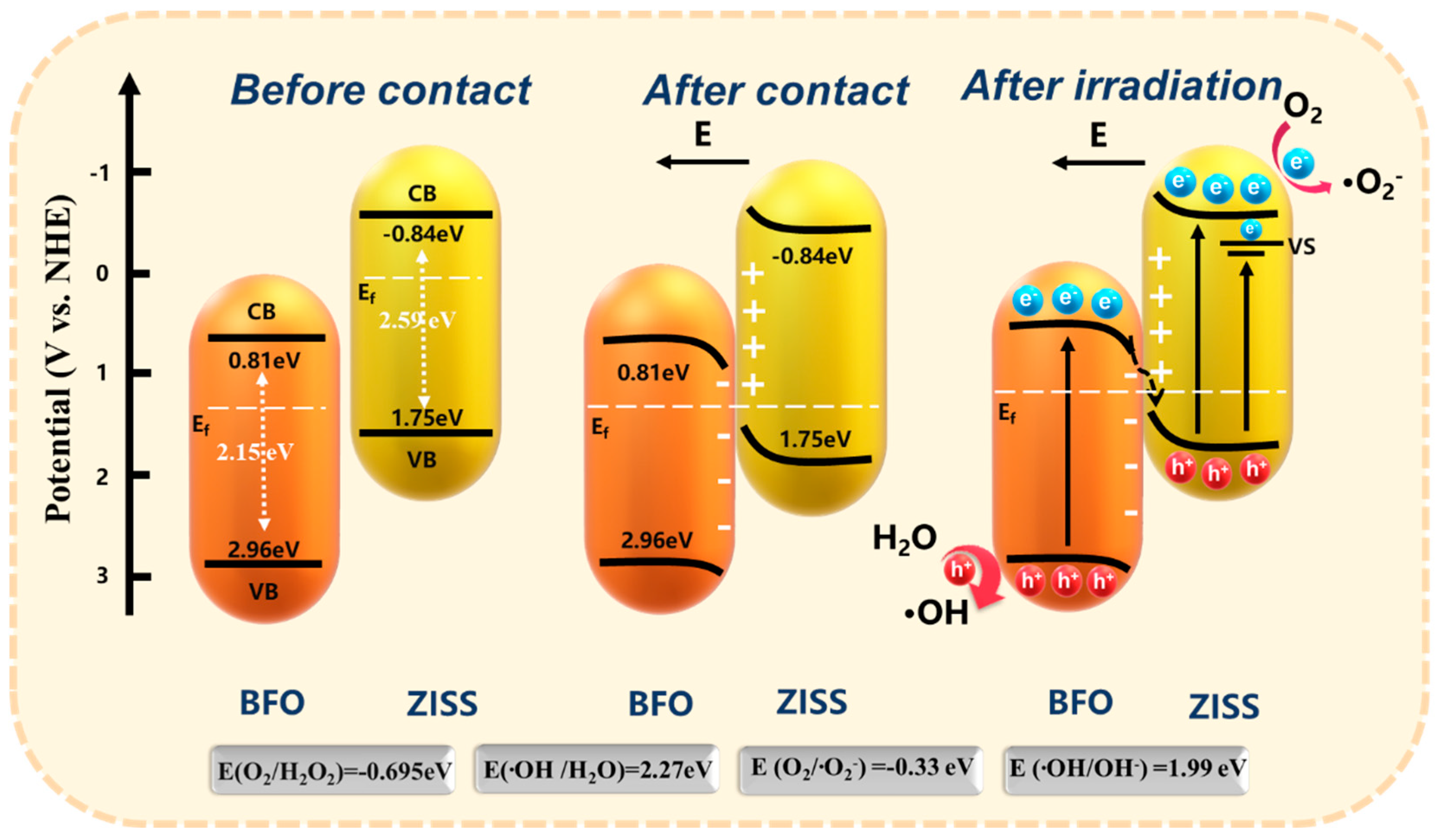
Disclaimer/Publisher’s Note: The statements, opinions and data contained in all publications are solely those of the individual author(s) and contributor(s) and not of MDPI and/or the editor(s). MDPI and/or the editor(s) disclaim responsibility for any injury to people or property resulting from any ideas, methods, instructions or products referred to in the content. |
© 2023 by the authors. Licensee MDPI, Basel, Switzerland. This article is an open access article distributed under the terms and conditions of the Creative Commons Attribution (CC BY) license (http://creativecommons.org/licenses/by/4.0/).




